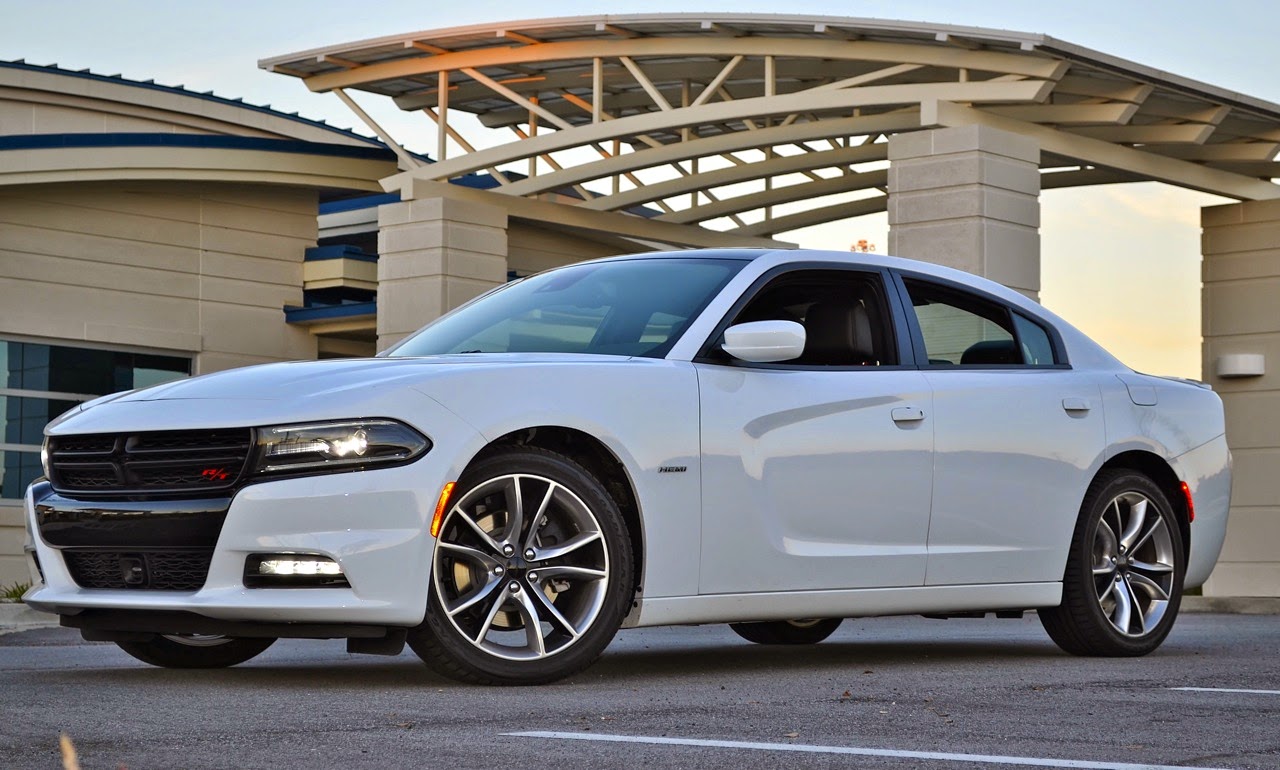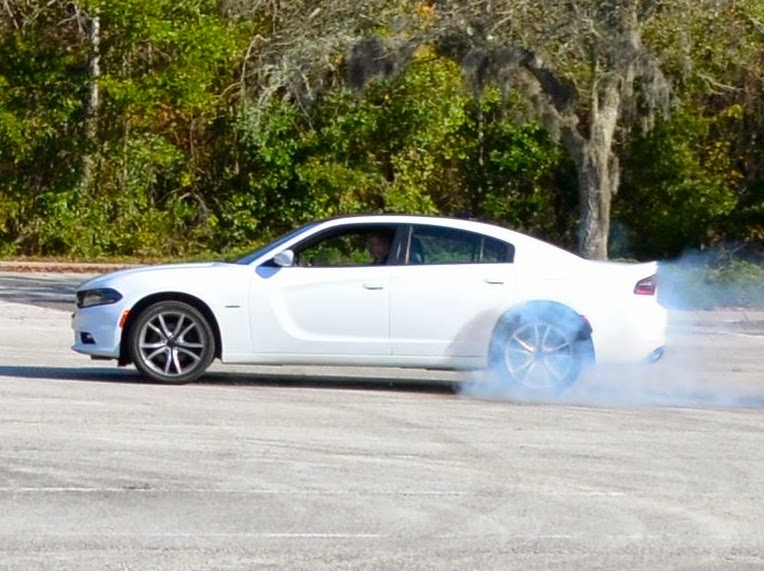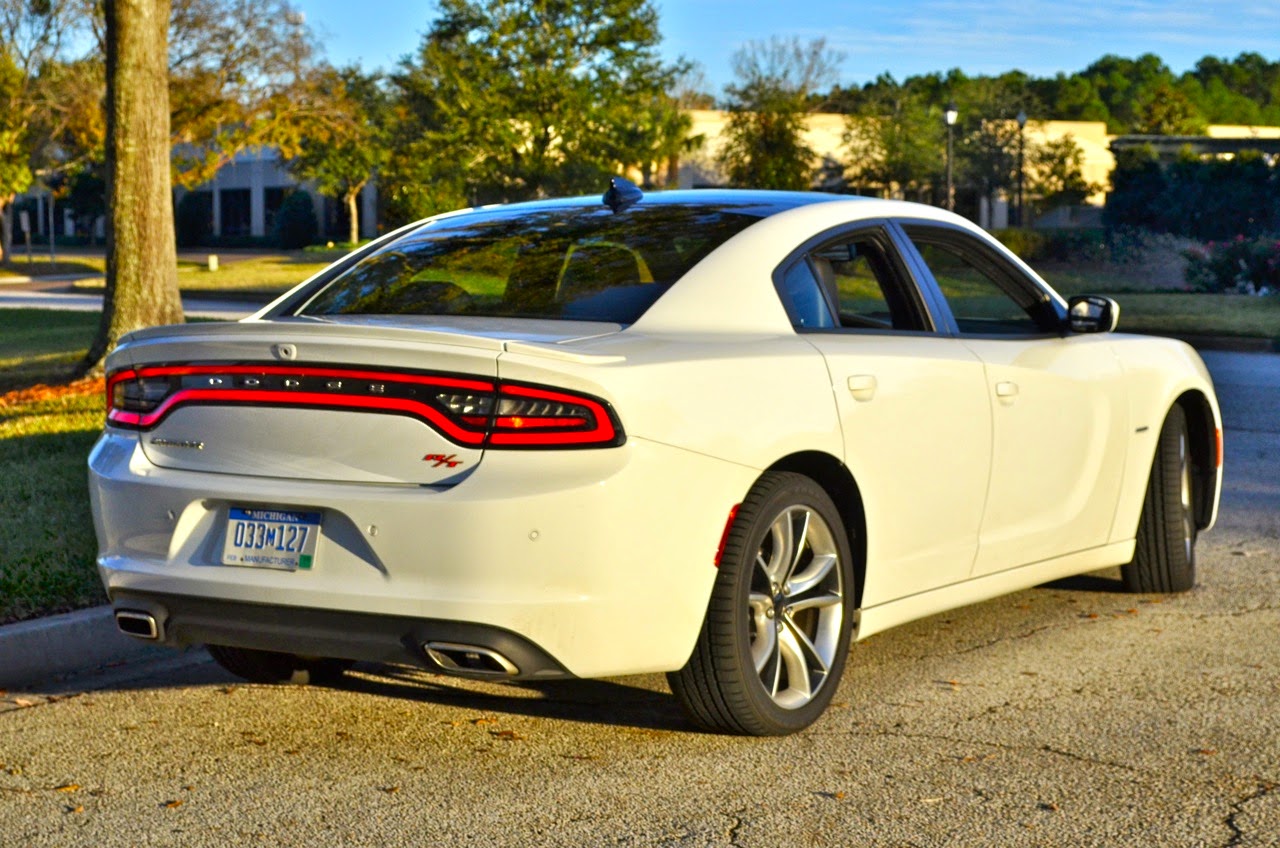The most iconic original Chargers came to market from 1966-1970. The last one was a front-wheel-drive compact hatchback before it died in 1987. Then came the sixth-gen Charger of 2006, the basis for this four-door. Chrysler re-engineered the rear-wheel-drive platform in 2011 with a door scallop that echoed the 1968-’70 models. And for 2015, the Charger got a new hood, fenders, front and rear lights and fascias, even front doors.
The hood line is lower and sleeker in front, flowing into a slimmer gloss-black crosshair grille. It’s flanked by slim LED headlights with U-shaped LED running lights for a very distinct look. R/T five-spoke polished 20-inch alloy wheels have black painted inserts and ZR-rated Goodyear
Eagle RS-A rubber. Dodge swears the side scallops are reshaped, and it restyled the C-pillar for a bit more of a fastback appearance as it flows into the trunk and its new spoiler. The continuous LED taillight ribbon is slimmer, and has a more diffuse lighting. The dual exhaust
tips are wider and integrated into a black lower fascia. Called it a more streamlined
overall shape with some serious attitude.
The 2015 redesign retouches the R/T’s capacious black and red interior with nicer soft-touch material and trim changes like contrasting stitching. You settle into shapely red bucket seats with Alcantara suede inserts and eight-way power adjustments. The dashboard face is framed in an aluminum honeycomb accent. The 160-mph speedometer and 7,000-rpm tach frame a new seven-inch color screen that shows a digital speedometer, fuel economy, engine power and torque gauges, tire pressure, coolant/oil/transmission temperatures and voltage. It even has a 0 to 60 mph timer.
More tech is in the 8.4-inch touchscreen display dash center: navigation, smartphone, backup camera, Sirius TravelLink weather/traffic/stocks/gas prices and a host of Uconnect apps. The screen also contains a new Performance Control display with launch control that allows you to preset the engine rpm for drag strip launches. You can set up comfort/normal/sport steering, pedal, engine and transmission response. Then there’s a Performance Page that shows 0-60, 0-100, 1/8th and 1/4th mile and braking distance, engine gauges and information on acceleration, braking and lateral Gs and steering angle.
Safety tech includes a collision warning and adaptive cruise. The lane departure assist actually nudges the Charger back in lane if you drift. It is over-sensitive. The 552-watt 10-speaker Beats audio system sounded great, with a subwoofer tucked in the trunk. The back doors open on a very roomy rear seat with carved-out bucket seats and twin air vents, two USB ports and outboard seat heaters. The trunk is huge, the rear seats splitting and folding 60/40.
Our Charger has a lot of brothers – the base 292- or 300-horsepower 3.6-liter V-6s; the R/T Scat Pack’s 6.4-liter HEMI V-8 or SRT 392 with 485-horsepower; and the Hellcat! Our 6,000-mile-old muscle car is smack in the middle – a 5.7-liter HEMI V-8 with 370 horsepower and 395 pound-feet of torque, ditching the five-speed for the new TorqueFlite eight-speed automatic getting a 3.07 rear axle ratio (vs. standard 2.62 ratio) on our R/T model. The result – 60-mph in a quick 4.7 seconds with just the pedal mashed, or a “launch control” time of 5.3 seconds with more computer-controlled wheelspin, both with a nice meaty exhaust growl. We could leave a bit or rubber on any launch with Sport Mode speeding up shifts and gas pedal response so the car leaps off the line. Our engine would roll into a relaxed four-cylinder mode on the highway for fuel savings, so we saw 18-mpg on average on regular gas.
Now, with two tons of domestic muscle car here, we’d expect the “performance” suspension to handle the weight and power, and it does for the most part. There’s an independent short/long arm front/5-link independent rear suspension with stabilizer bars. The firm but comfortable ride swallowed bumps and didn’t lose rear end composure in a lumpy turn. It was a predictable rear-wheel-drive sports sedan with minimal lean and lots of grip. Get enthusiastic and measure some throttle in a turn and the tail steps out, traction control grabbing it. Tap in the sport setting, which loosens the safety nannies in the traction control, and the rear rubber power slides out further. Using the G-Force meter, we routinely saw .91 in lateral Gs on the skid pad before the tail began powering out, with a best of 1.06. Our peak G-force under acceleration was .72. The brakes really hauled us in, averaging about .83 Gs in deceleration.
When it rains, it’s a different story. Because of the quick throttle tip-in, I found the tail eager to go wide even when we carefully took a corner. It’s easy to control, but a bit daunting. The electric power steering had driver-selectable modes – normal, comfort and sport. I kept it on “sport” for a more direct feel with better feedback, albeit a bit artificial.
We had 14.2-inch front/13.8-inch rear disc brakes with Brembo four-pot front calipers. They offered a precise pedal feel with solid stopping and no fade. There’s no getting around it – this is a big and slightly old-fashioned muscle car with a well-developed platform that still has some old school in it – enjoy and respect it!
A base V-6 Charger SE starts at $27,995, while our R/T Road and Track started at $32,995 with the 370-horsepower V-8, eight-speed automatic and keyless entry. The rest was all options, the biggest the $3,000 Super Track Pak with sport suspension, three-mode stability control, Brembo brakes, 20-inch tires and wheels, black grill, leather/suede seats, alarm, power pedals, ventilated front seats, 3.07 rear axle ratio and some more go-fast and look-fast items. The $1,795 tech package adds the safety items including rain-sensitive wipers, while $1,500 added the black roof and $1,195 the moonroof. The $795 option package added the blind spot detection and those mirror courtesy lights, while navigation with the 8.4-inch touchscreen and back-up camera added $695. With destination, the price was $43,965.
The changes made to the ‘15 Dodge Charger R/T’s looks really matter when it’s coming and going, as well as inside. In fact, the streamlined changes make it look smaller. But it’s still a big ol’ muscle car, and while that’s a lot to love, is it too much?
For more information about the 2015 Dodge Charger lineup, please visit http://www.dodge.com/en/charger/









